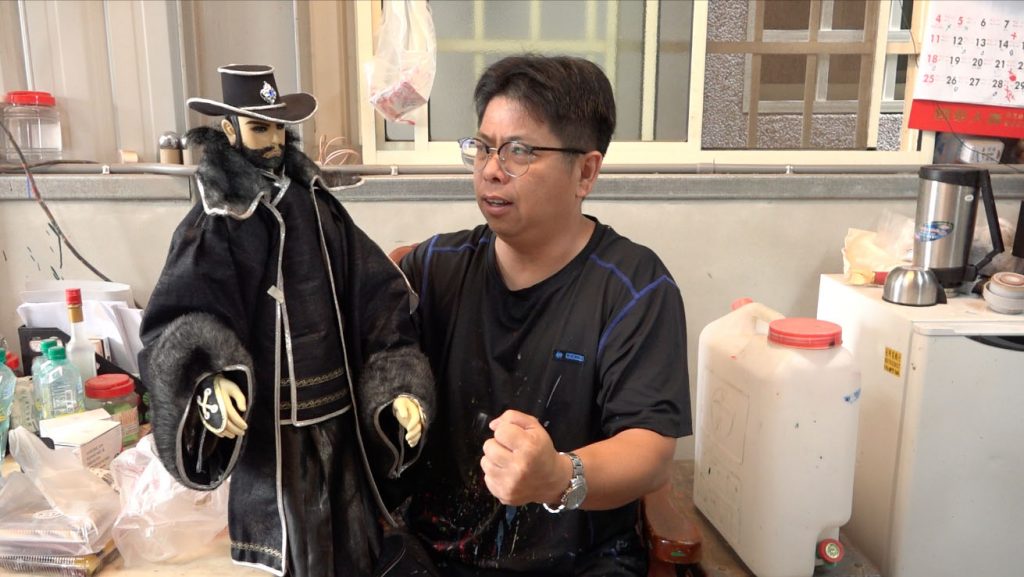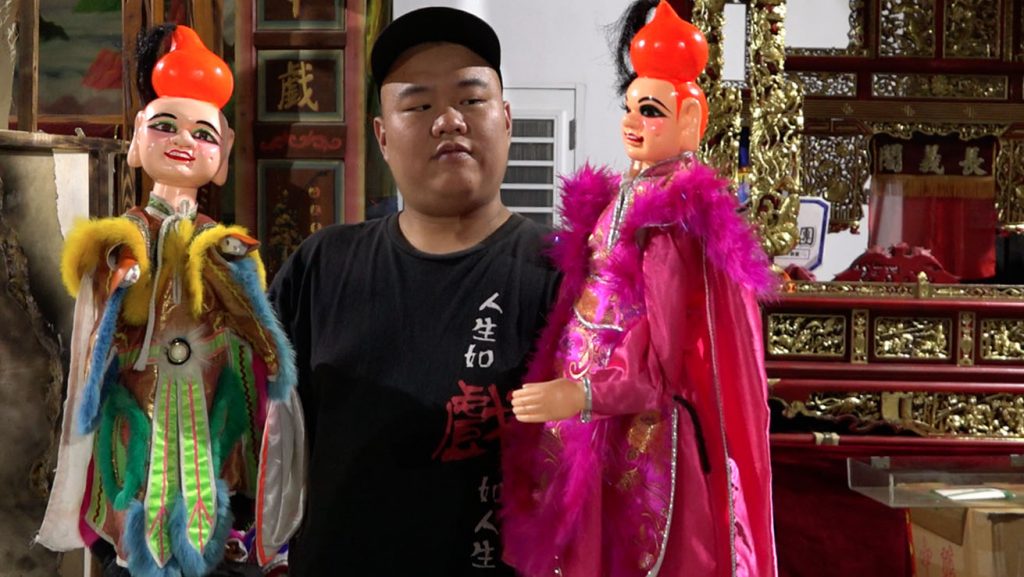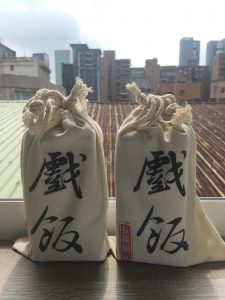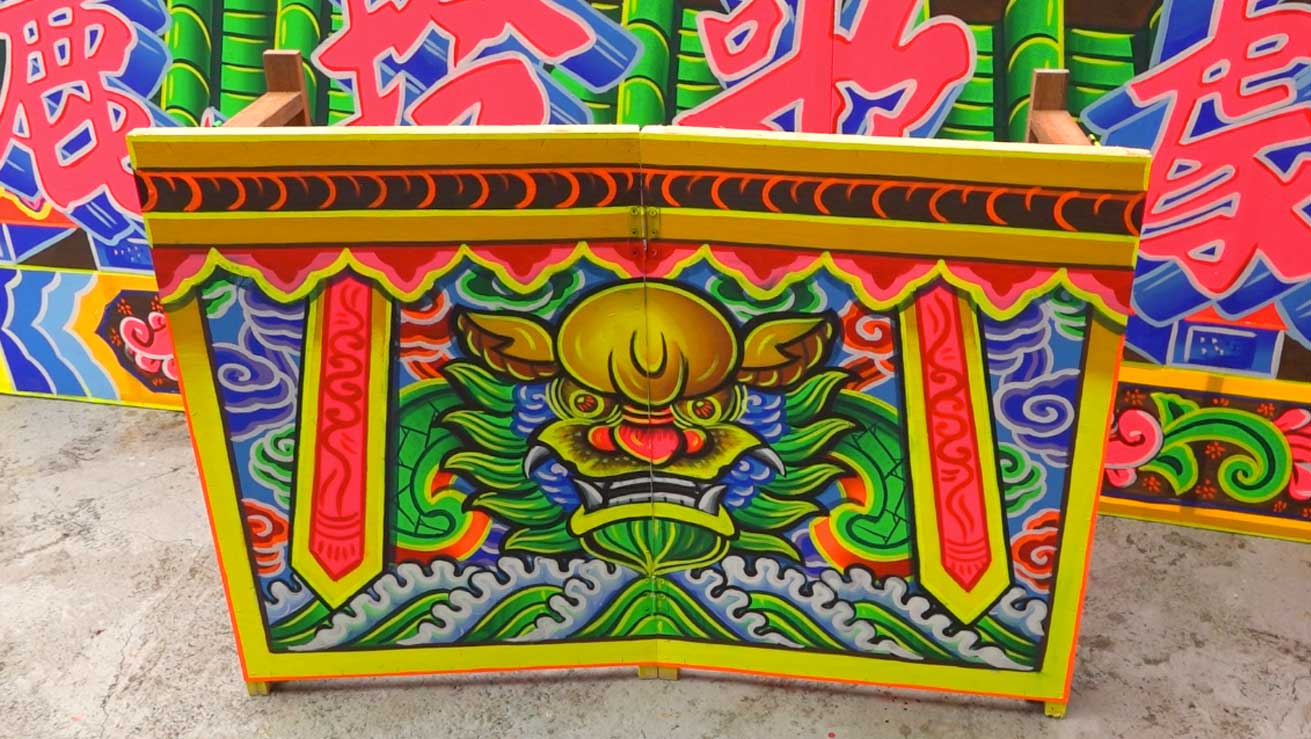Budaixi exists in many forms and has produced regional variations in Taiwan. To learn more we did a research trip to the South of Taiwan and visited six different troupes, whose members shared their time, skills, knowledge and food with us very generously. Thank you:
明興閣掌中劇團 Ming Hsing Ke Glove Puppet Theatre
A big thanks also goes to Megan Yu Hua Lan who organized all the meetings and worked tirelessly as our translator.
We started out by visiting an outdoor show by 真雲林閣掌中劇團 ZhenYunLinGe at the medical university campus in Kaohsiung. The stage was set up outdoors under a roof of brutalist concrete. In front of the stage were several rows of folding chairs. A red rope signaled that everyone who entered the roped off area and sat down would transition from being a casual bystander to being an (captive) audience member. The show, according to the event organizer, aimed to introduce medical university students to Budaixi and JinGuang type puppet performances and therewith the traditional arts of Taiwan. The organizers also hoped it would provide the medical students with a chance to relax and have some fun.
真雲林閣掌中劇團 collaborated with several other puppet troupe members and delivered both: education and fun.
The next morning we visited Mr. Lee from the 真雲林閣掌中劇團 troupe in his studio in Chiayi. He and an assistant were in the middle of painting panels for a new stage. Due to the tropical climate in Taiwan, the wood for the frames is cedar, which is imported from Vietnam. It’s long lasting and Mr. Lee keeps discarded stages to recycle the materials for new stages. His designs are dense and colorful and resemble the front views of temples in an abstracted manner. Neatly composed architectural elements, like columns and roofs are surrounded by free flowing mythological creatures, like dragons and lions. The designs are usually symmetrical. Mr. Lee explained that he usually sketches out one side of the panel with chalk and then presses these chalk outlines on the opposite panel to achieve the symmetry. Especially for outdoor performances at temple fairs where no seating for the audience is provided, the stage design aims to attract the attention from people passing by with the help of neon colors that – for extra effect – those colors glow in black light.
Mr. Lee ordered lunch and delicious snacks and while we ate we talked and listened and learned. Founded in 1975, 真雲林閣掌中劇團 is now run by the second generation. Mr. Lee’s father who did not see a sustainable future for Budaixi in Taiwan, advised his son to not continue the family tradition, but Mr. Lee persisted. He learned how to narrate an incredible range of characters by watching his father. Mr.Lee is open to incorporate all kind of new inventions into Budaixi performances, yet he insists that one traditional aspect needs to be kept: One person narrates the entire show and all its characters. For Mr.Lee this is a very important and a typically Taiwanese feature of Budaixi.
For his stories Mr. Lee mixes local Taiwanese folk tales with classic Chinese folk tales and also incorporates comments on current political global and local events. What he loves about performing at temple fairs is the freedom and fun to improvise with the other troupe members.
One puppet Mr. Lee is using in a show about the Dutch colonization of Taiwan is the character of Zheng Chenggong. The puppet is designed for TV appearances, its eyes and mouth can be moved from inside the head.
Zheng Chenggong, Western name Koxinga, or Coxinga, (born Aug. 28, 1624, Hirado, Japan—died June 23, 1662, Taiwan), pirate leader of Ming forces against the Manchu conquerors of China, best known for establishing Chinese control over Taiwan. More interesting info on Zhen Chenggong can be found here.
In the afternoon we visited 義興閣掌中劇團 Yi Sing Kuo whose performance Marvelous Rider-G we had seen in an outdoor theater in Dadaocheng in Taipei a few weeks earlier. What had amazed us about this show was Mr. Wang’s highly energetic way to narrate the entire show while incorporating rock guitar solos.
義興閣掌中劇團 Yi Sing Kuo Puppet Troupe is a puppet performance troupe in Chiayi City founded in 1953. It is now under the management of the 4th generation owner. Formerly specializing in Jin Guang glove puppetry, the troupe has broken the traditional mold of glove puppetry under the management of the next-generation successors. Having grown up surrounded by glove puppetry, the young 4th generation male leading role Wang KaiSheng not only possesses abundant experience in the craft but is also a lyricist and composer. His big contribution was to replace the traditional musicians with a live rock band to provide the soundtrack.
During our meeting Mr. Wang’s grandmother brought a plate of fresh pineapple and papaya as snacks. It was the sweetest pineapple we have ever tasted in our lives. Mr. Wang talked about making available information and education about glove puppetry in Taiwan via a podcast, which he will launch next month. For the podcast two puppet characters will interview puppeteers and practitioners. Mr. Wang also showed us a few puppets he made for a previous performance with autobiographical elements – the puppet to the right resembles Mr. Wang, the one to the left resembles Master Wang’s father as a young man and the one in the middle resembles his father later in life.
In the evening we visited 長義閣掌中劇團 the Chang Yi Ge Pavilion Zhang zhong Theater Troupe. The troupe was founded in 1945. It has been in existence for 75 years and has been passed down for four generations. In 2013, it was preserved as an intangible cultural asset of Chiayi City and selected as an outstanding performing arts team in Chiayi City for 20 consecutive years. It was also selected by the National Cultural and Art Fund in 2020.
The troupe has long invested in the front and back field training program of puppet shows. Since 2014, it has signed an industry-academic cooperation with Nanhua University, recruiting students from the Department of Ethnomusicology to learn traditional opera music and accumulate skills through the form of “cultivating skills through opera.”
The works of Changyi troupe attempt to build on the concept of geography and history through combing historical materials, field research, and interpretation of drama. Using “tradition” as the sword they demarcate the framework and establish a narrative language unique to Changy through deconstruction. In addition to keeping traditional elements in the palm of the hand, it can also continue to innovate and pass on. (above text was translated via Google from the troupe’s website.
Once a week 長義閣掌中劇團 host classes for elementary students in their studio space to teach them about Budaixi. Besides the main rehearsal space the newly built studio building also houses a sound studio (for recordings and practicing music without disturbing the neighbors) and a small museum on the top floor, where 長義閣掌中劇團 showcases artifacts from the troupes history. Mr. Ling, who is 26 years old, took over the role as the leader of the troupe from his uncle when he was 19 years old. With on-hand examples Mr. Ling and Mr. Gao showed us how puppets evolved in size and proportion – from the smallest one used in traditional Budaixi, to the slightly bigger one, used in temple fairs, to the JinGuang (Golden Ray) one with the bigger head and finally the biggest one, which has to be operated by two people and is used in TV productions. The actual character, seen in the picture below, is a homage to Mr. Ling’s grandfather whose nickname was “gourd.”

Towards the end of our visit we were each gifted a bag of local rice. During the pandemic, when traveling became restricted 長義閣掌中劇團 collaborated with local rice farmers on a video and promotion project which compares growing rice with playing Budaixi – both are activities that take a lot of time and patience and nurture the community.
This is an excerpt of some of the narration from the video 長義閣掌中劇團 made:
Each grain of rice results from hundreds of drops of sweat.
Each show results from three to five years of dedication.
Farmers farm at the mercy of nature.
We perform by the rules.
Growing rice requires patience.
Supply it with Sunlight, give it water, wait until it is ripe.
Reaped, sun dried, milled, cooked and finally served at the table.
What we eat comes from heaven, earth and the farmers contribution.
Performing a show requires patience as well.
From carvin puppet heads, sewing puppet clothes, to painting the settings.
Only when the sound of the gong emerges, will the puppets come out to tell stories and histories.
What we see also comes from heaven, earth and the performers dedication.
Rice gives our bodies strength, shows make us full of spirit and energy.
We eat while we see shows. Seeing shows and eating are both part of daily lives

The next morning we visited 蘇俊穎木偶劇團 Su Jin Yin in Tainan. We were welcomed with a breakfast sandwich and tea. Later, when we ate some pineapple cookies, we learned that Mr. Su not only runs a puppet troupe but also a pineapple cake factory.
Su Jun Ying was introduced to Budaixi and learned many of its traits by growing up next to the temple. In junior high school he began to perform his own puppet shows with classmates in the library, and eventually started his own puppet troupe. The front room of Su Junying’s house contained glass vitrines with puppets. Many of those Mr. Su had carved and painted himself. Mr. Su draws inspiration from traditional folk stories, myths and daily life.
There are several rooms and studio spaces in which Mr.Su stores puppets, props, stages, book and also old scripts. His grandfather was a professional storyteller, who told stories, which he learned from a series of books. Besides the books his grandfather used, Mr. Su also showed us several handwritten scripts he had inherited from an old puppet master. The handwritten books were used like reference books for puppet plays, they roughly describe a scene or a character and what is happening.
After inviting us for lunch, we visited a nearby temple, where Mr. Su had up his stage to perform a puppet show for the Goddess Mazu. Mazu, the Goddess of the Sea, migrated to Taiwan with the people of Fujian Province in the 17th century to become one of the most revered deities on the island, where today about 870 temples are dedicated to her worship. Mazu’s birthday falls in the third month of the Chinese lunar calendar, and at that time temples all over the island hold birthday activities including the burning of incense and tours of the deities around their domains. We were lucky to visit the South of Taiwan during the Mazu birthday celebrations. We had heard several times that the main purpose of a traditional puppet show is to entertain the gods and deities on their birthdays, that traditionally puppet shows are not necessarily performed for human audiences, but we never had really experienced a show like that.
Now we had a chance, watching Mr. Su perform. Mr. Su told us that for these kind of temple shows the budget is often rather small, so puppeteers adapt by performing individually or in pairs and using a prerecorded soundtrack instead of live music. For his show at 善化慶安宮 (Shanhua Qing’an Temple) Mr. Su performed 扮仙祈福 BannSehn (Playing the Role of God).
operated all puppets by himself and used a prerecorded soundtrack and augmented that through live narration. 扮仙祈福 is a drama “where the puppets play the role of gods in the sky and pray to the god for blessings. The task is to congratulate the world on happiness, and the way of congratulating is to bring treasures and say a piece of auspicious words for each. Pretending to be an immortal is the opening scene and the most important part of folk acting activities. Taiwanese folks, regardless of any type of drama, must pretend to be immortals and pray for the believers before performing formal dramas.” more info here
On Saturday morning, May 1st, 2021, we visited Goodoo Studio. GooDoo Puppet Troupe is a modern troupe based in Tainan, founded in 2000 by Huang Guan Wei. While several rounds of firecrackers kept exploding at the nearby temple in celebration of Mazu’s birthday, Mr. Huang spoke how he collaborates with local business men and corporations on individualized puppet shows that tell a company’s history and values. His specialty is video and post production, many of his puppets perform for the camera and undergo editing and post production special effects.
Mr. Huang finished his formal school education at the age of thirteen. He learned by working, apprenticing or interning for many different companies and puppet troupes. Goodoo Studio acts, directs, shoots, edits and adds a lot of visual effects in house. For post production they use After Effects. In 2018 GooDoo was commissioned by Tainan Danzai noodle restaurant Du Hsiao Yueh (度小月) to create a puppet video to celebrate the 123rd anniversary of the restaurant’s founding. The full video can be watched here
When creating new plays Mr. Huang sometimes works like a local historian, doing a lot of field research in preparation, visiting libraries and local archives and conducting interviews with residents. Most of the troupes plays are performed in Taiwanese. Mr. Huang explained that traditional Budaixi Puppets were originally from Mainland China and much smaller in size than their more recent Taiwanese counterparts which are larger and have a bigger head.
In the afternoon, after making a few stops along a Mazu parade (see above) in Tainan we drove to Pingtong and visited 明興閣掌中劇團 Ming Hsing Ke Glove Puppet Theatre. 明興閣掌中劇團 was founded by Su Mingshun in 1957. It has more than 50 years of experience from stage performances in theaters to wild stage operas. Ming Hsing Ke is a family troupe which means, the Su’s family members do everything: puppeteering, costume making, narration, music, props, stages, administration etc. The Su family is recognized by their characteristic performance, their way of animating the puppets, “jocular and amusing uttered words, stirring and exciting story moves along with traditional Beiguan music performed at spanking pace. Besides the religious festivals, arts and cultural activities, you can also see their participation in multiplex cross-field at educational activities, environmental propaganda and advertisement for labor law. By introducing the traditional puppet arts to public via different channels, their road is expanded.” (From the Ming Hsing Ke Glove Puppet Theatre promotional brochure)
Mr. Su has specialized in making headdresses and costumes. He has learned sewing from his mother. He shows a selection of headdresses and a traditional embroidery frame and explains the many steps that go into production of a handmade Budaixi costume. Overlapping seams on a headdress are invisible for example, because they are always covered with a string of beads. The shape, form and color of each headdress signifies the rank or profession of the character, as well as the time when it was used. Within these strict rules is a lot of space for invention and playfulness. It takes between 3 to 7 days to finish a headdress.
We also get a demonstration in puppeteering. The head of a puppet is supported by the index finger and it always has to stay vertical. Puppeteers need great flexibility in their hands to move the arms (one with the thumb, the other one with the three remaining fingers.)
To see easier how the magic works, 俊榮師 demonstrates the movements using a puppet that wears a transparent dress.
more about the troupe: https://www.youtube.com/watch?v=kdWo1JFj6zU
Following an invitation from Su Yun Ying from evening we drove to Baihu near the city of Chiayi to attend a temple fair in honor of Mazu’s birthday – the goddess of the sea. Several puppeteers had mentioned to us that they preferred to perform at temple fairs, because it allowed for more improvisations.
We arrived in Baihu 台南市(Tainan City) 白河區(Baihe District)
around 6pm, when it was already dark. We parked the car, walked around the corner and followed three intertwined strings of firecrackers that lay on the road like dangerous snakes. Along the road some shopkeepers had installed a video screen on which they video projected a Chinese opera performance. The 中妙宮 Zhong Miao Gong temple was brightly lit and across from it two puppet stages were set up. The bigger one was from the Fu-Cheng Puppet Troupe who on this night collaborated with 蘇大俠 Su Jung Ying on 天龍遊俠傳 (tian long you xia chuan) “
The Legend of Dragon Ranger.”
The smaller stage was manned by only one puppeteer and it looked like the play performed was the same, or a similar one that Mr. Su Yun Ying had performed at his hometown temple to greet Mazu.
There could not have been a better ending to our research trip than this temple fair. Thank you everyone for letting us learn about traditions, innovations, adaptations and practices that make Budaixi and Taiwan such a special place.



























































































